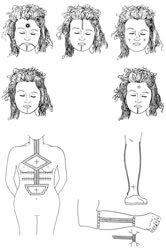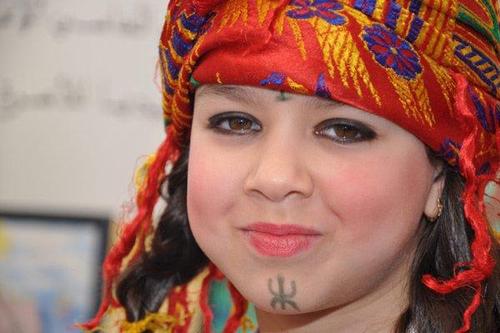One of the most frequently asked questions received by The View From Fez concerns the Amazigh (Berber) tradition of tattooing. Although tattoos are most often seen on older women, they are making a comeback among younger women
For the more conservative Arab members of society the tattoo is said to be prohibited in the Qur’an, yet despite this, tattooing has survived for centuries in the Islamic societies of North Africa.
According to the opinion of Moroccan religious scholars interviewed in the 1920s, getting a tattoo was strictly “forbidden” since the seat of the tattoo caused injury; the pigment, impregnated with blood, remained under the wounds thus rendering the body imperfect in the eyes of Allah. Furthermore, they claimed that a tattoo was an obstacle preventing water from penetrating the skin during the ritual ablutions of purification: one of the five fundamental precepts of Islam.
However, Moroccan women considered certain tattoos as legitimate. The popular religious doctrine of Hadith, the collection of sayings of the prophet Mohammad that constitute a major source of guidance for Muslims after the Qur’an, claims that ghemaza (tattoo between the eyebrows) and siyâla (tattoo on the chin) are traditional. For example, early 20th century literature has recorded that tattoo existed in Arabia at the time of the Prophet Mohammed: “All women were tattooed and Lalla Fatima Zahra, the daughter of Mohammed, very probably wore the siyâla, which is attributed to her in Moroccan belief.” Even women living today sometimes say, “Fatima gave this [siyâla] to us,” or “Tasnida D-Lalla Fatima Zahra,” this tattoo is “dedicated to Lady Fatima Zahra.”
 |
| “Tasnida D-Lalla Fatima Zahra,” |
Within the Amazigh communities of North Africa, the practice of tattooing dates back to pre-Islamic times and the technique of tattooing existed since the Neolithic. They were far more than simply body adornment, having far deeper levels of significance which vary from tribe to tribe.
While the most visible tattoos are on the cheeks or chin, where it might indicate marital status or tribal affiliation, tattooing was not restricted to the face. As a protective talisman, tattoos retain elements of atavistic animism: a belief that supernatural energy (baraka) resides in all things. Amazigh tattoo designs hold the sacred energy of baraka which can be used to deal with the darker forces of life, to cure illnesses and to protect oneself against spirits called jnoun (singular: jinn). Oftentimes Amazigh tattoos were placed near body orifices (eyes, mouth, nose, navel, vagina) or surfaces believed to be vulnerable to the machinations of evil. For example, tattoos usually marked the feet to protect women from jnoun who attempted to enter the body through the earth. Other designs on the ankles, hands, and face were believed to protect individuals from the evil eye. Thus, it is not surprising that many Amazigh tattoos carry the tag of jedwel or “talisman.”
It is widely believed that one can escape the power of the jnoun by plunging an iron knife into the ground. The use of an iron needle in tattooing is thought to have a similar effect and will protect the individual.
The most common Amazigh term for tattoo is oucham (“to mark”). Tattoos were traditional or l-qayda (“custom”) and some motifs were rooted in the ancient Amazighalphabet known as Tifinagh. The Tifinagh is a figurative alphabet derived from tools used in agriculture, sea products, and constellations. Upon examining the list of extant letters, more than a dozen Amazigh tattoo motifs are common to the alphabet and these symbols generally appear on the chins of Amazigh women as siyâla.
The motifs widely recognised in the Amazigh tattoos are divided between a few categories, mainly vegetal motifs, such as the olive tree, which represents strength because of its Amazigh name azemmur, related to the term tazmat (strength); wheat, which is a display of life (because of its sheath) and death (because of the seeds being in the ground); or seeds, which are a reference to masculinity, they represent manhood and are a symbol for life and fertility; and metal objects, which make the allusion to the blacksmith, such as the hammer, which represents power, natural forces and creative power. It is a very important instrument for the blacksmith because it enables him to change the iron into various shapes; the anchor, symbolising solidity, continuity, faithfulness, balance and lucidity; the axe, which is a sharp instrument and represents anger and destruction – however, since it attacks evil forces, it is a positive symbol, associated with the lightning and rain (therefore fertility); and the arrow, a cosmic projection associated with lightning, which represents male energy and fertility.
 |
| Tattoos of the Rif Amazigh of Morocco, ca. 1930 |
But not all Amazigh tattoos were literal in this sense. In the early 20th century, the Rif Amazigh women of Morocco, among others, practiced tattooing as a prerequisite for marriage. When a girl was certain that she was to be married and when all arrangements for her wedding had been made, her family called in an old woman of the same awar, or sociological family, who was expert in the indelible art. If no such woman was available, one was called in from outside and if the tattooist was related to the client no fee was paid.
Next, the old tattooist began preparing her liquid tattoo pigment of lampblack and juice squeezed from the leaves of broad (fava) beans. According to Amazigh scholar Pierre Bourdieu, broad beans (ajedjig) embodied multiple referents for the Amazigh. Firstly, dried broad beans were male symbols akin to human bones. Secondly, "being a desiccated seed which, after burial in the damp womb of nature, it swells and comes up again, more numerous, in spring," the broad bean also symbolised the refuge of the soul awaiting resurrection.
This transition to a new life would be filled with discovery, but more importantly it would be marked by transformation; since after the tattooing the girl would become a woman, a sexual being who was accorded a new status that had the potential to bring her greater social recognition and fulfilment via the sanctity of motherhood. Amazigh women, as the centre of the family’s sacred identity and guardians of the family’s honour and reputation, were situated within a socio-moral universe that affirmed their importance in everyday society. They were responsible for all magical practices intended to safeguard life (e.g rites against the evil eye), and those designed to maintain the life of their children for which they were responsible - as well as the generative powers of which they are the bearers.
For those interest in discovering more about Amazigh tattooing, note that the The Dar Bellarj Foundation in Marrakech are holding an exhibition "Engraved Woman" until October 31, 2018.
This exhibition explores the tradition of tattooing. Often considered a taboo, the tradition of tattooing in Morocco is linked to a very old pre-Islamic rite. It is "mainly associated with Amazigh culture, whose function is as much ornamental as prophylactic, identity and medicinal," said a statement by Dar Bellarj. And to add that although proscribed by Islam, the practice has long endured, thanks to its symbolic strength in the field of the sacred. At a time when it seems more and more threatened, five young Maghreb artists worked on this controversial heritage and questioned him, each with his medium, his approach, his eyes, to avoid fatal amnesia.
In this exhibition, we find the work of Moulay Youssef El Kahfai, Noureddine Tilsaghani and Wassim Ghozlani, accompanied during their creative residency in Dar Bellarj of two young laureates of the Graduate School of Visual Arts in Marrakech: Maha Mouidine (graphic designer) and Marouane Bahrar (photographer).
Each of the points of view of these artists are intertwined and dialogue in the space of Dar Bellarj, next to a collection of the Berber museum of original photographs of tattooed women, loaned by the Majorelle Foundation, by Jean Besancenot, in Morocco, at early twentieth century.
In addition to the exhibition, meetings, conferences, workshops with artists and craftsmen, film screenings in the presence of the filmmakers allow to continue the mission of the Dar Bellarj foundation: to enhance the Moroccan heritage by the look and feel gesture of contemporary artists.
Created by the Swiss patrons Susanna Biedermann and Max Aliot at Riad Dar Bellarj in Marrakech, the Dar Bellarj Foundation for Culture in Morocco aims to enhance the Moroccan architectural and artistic heritage, and contribute to the influence of the living culture of Morocco. Morocco. Open to all, the Dar Bellarj Foundation offers throughout the year a program of events and cultural activities articulated around four major axes: the enhancement of tangible and intangible heritage of Morocco; support for artistic creation and crafts; the research ; the transmission. Dar Bellarj has already hosted exhibitions on earthen architecture, plaster art, embroidery of today's Morocco, Al Halqa or the "Nomadic Trace".
SHARE THIS!




1 comment:
Thanks for this wonderful post thetattooideas
Post a Comment